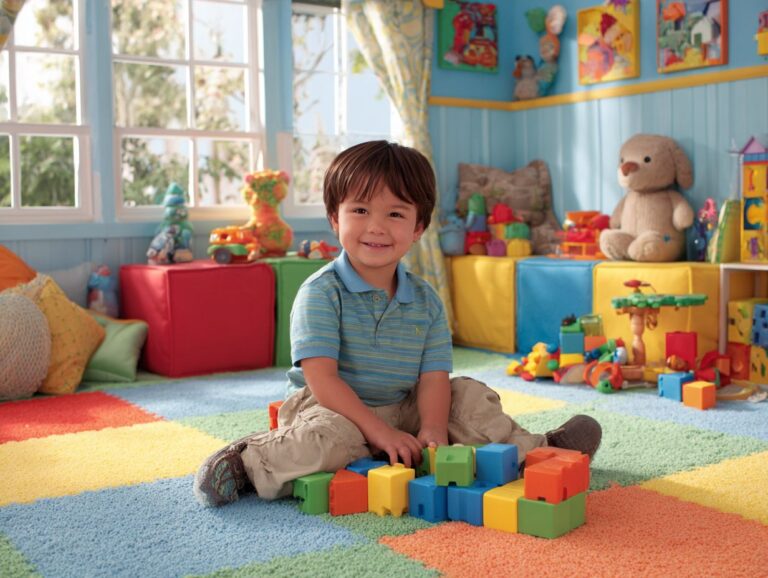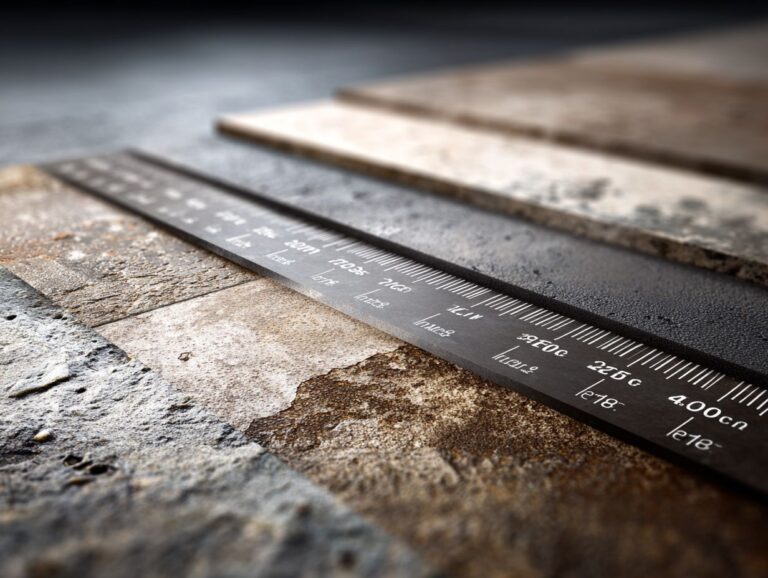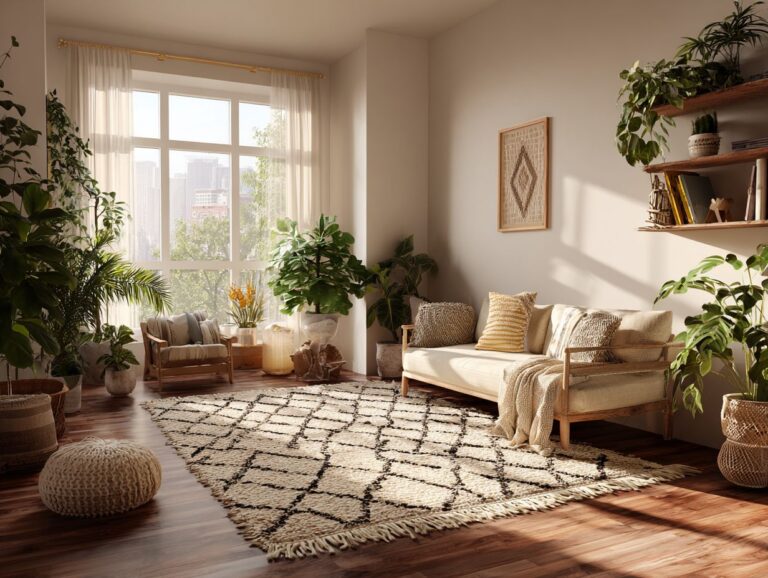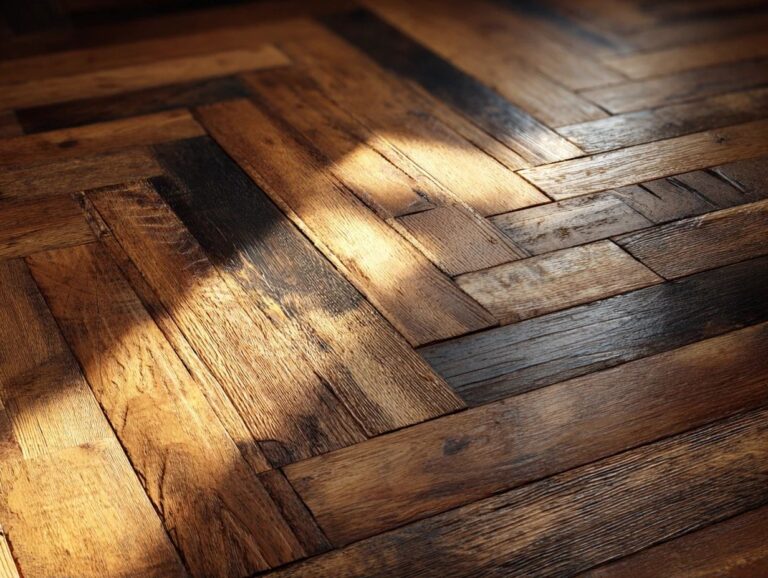Best Flooring for Rental Properties – Durability vs Cost
Choosing the best flooring for rental properties involves a delicate balance between durability and cost. Vinyl plank flooring offers a popular, resilient option, while carpet flooring can provide warmth and comfort. In this article, we’ll look at different flooring types, comparing installation costs and long-term advantages, to help you make a well-informed choice that improves your rental property’s attractiveness and worth.
Key Takeaways:
Contents
- Factors to Consider When Choosing Flooring
- Types of Flooring Options
- Durability Analysis of Flooring Types
- Cost Analysis of Flooring Types
- Rental Property Flooring Depreciation
- Frequently Asked Questions
- What is the best flooring for rental properties if I want to balance durability and cost?
- Is laminate flooring a good option for rental properties?
- How does carpet flooring compare to other options for rental properties?
- Can hardwood flooring be a good investment for rental properties?
- What are the benefits of using ceramic tiles for rental properties?
- Are there any other factors to consider besides durability and cost when choosing the best flooring for rental properties?
Importance of Flooring in Rental Properties
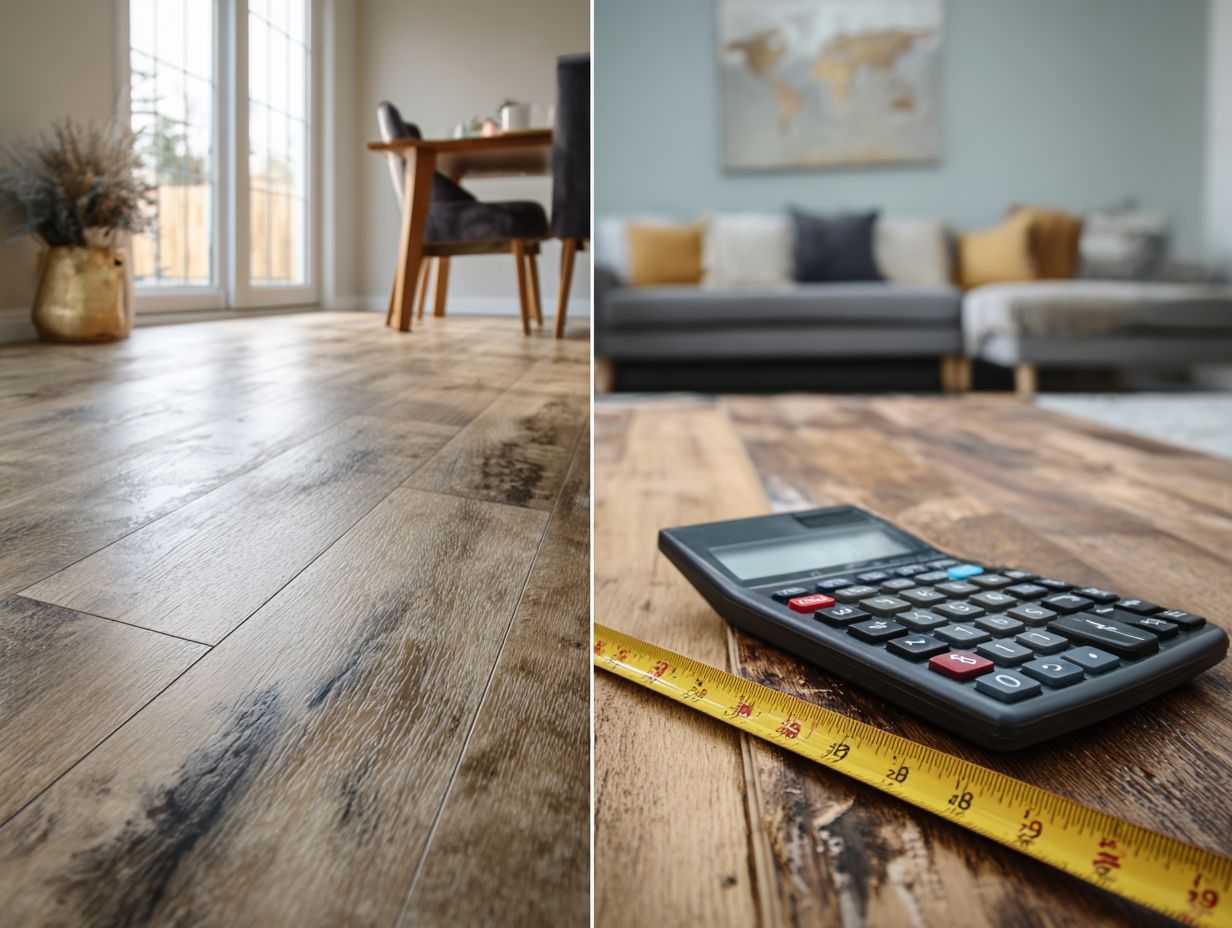
Quality flooring can significantly impact tenant satisfaction, leading to longer lease agreements and reduced turnover rates.
Research indicates that 85% of tenants prefer homes with high-quality flooring like hardwood or luxury vinyl tile, which improves the look of the property.
For instance, investing in laminate flooring can yield a 70% return on investment, appealing to tenants who prioritize style and comfort.
Properties with clean and well-kept floors are often seen as more sanitary, which helps keep tenants for longer periods.
By focusing on good flooring, landlords can satisfy what tenants want, increase their investment worth, and lower the chances of having empty units.
Overview of Durability vs Cost
Balancing durability and cost is essential, as the right choice can minimize long-term maintenance and installation costs.
To achieve this, start by comparing materials such as laminate, hardwood, and vinyl. For example, while laminate may cost less upfront, lasting durability of hardwood can result in lower long-term replacement costs.
Using a flooring calculator can help assess total costs over time, factoring in both installation and maintenance. Spending more on better underlayment can make your flooring last longer, offering insulation and protection from moisture.
Selecting quality options like luxury vinyl that offer durability alongside a reasonable price can yield significant savings in the long run.
Factors to Consider When Choosing Flooring
Choosing the right flooring needs you to think about how tenants live, how much upkeep it needs, and the impact on the environment. Additionally, deciding whether to refinish or replace your flooring can significantly affect maintenance and sustainability. For guidance on making this decision, learn more in our comprehensive guide.
Tenant Lifestyle and Usage
Knowing how tenants live and use their space is important in choosing flooring that handles daily use and meets special requirements, such as options suitable for pets.
For families with pets, options like luxury vinyl tile (LVT) are ideal, as they offer durability and scratch resistance while being easy to clean.
For young professionals, hardwood floors add a stylish look to an apartment. For improved moisture resistance, think about using engineered wood.
Carpet tiles can be a convenient choice for flexibility and easy replacement, especially in shared spaces.
Assessing lifestyle habits and maintenance preferences will help in selecting the most suitable flooring solution.
Maintenance Requirements
Maintenance requirements vary across flooring types, impacting long-term costs and tenant satisfaction.
Carpet should be vacuumed often and cleaned well every 12-18 months, costing around $0.15 for each square foot.
Hardwood floors usually need sanding and finishing every 5-10 years, which costs around $3-$5 per square foot. Regular sweeping and mopping help maintain their condition.
Tile flooring is durable and largely maintenance-free apart from occasional grout cleaning, averaging about $1 per square foot.
Knowing these needs helps tenants handle maintenance well and leads to better landlord-tenant interactions.
Environmental Considerations
Choosing eco-friendly flooring can make a property more attractive and satisfy tenant requests for green living.
-
To choose sustainable flooring, consider materials like bamboo, cork, or reclaimed wood, which reduce environmental impact.
-
Search for certifications like LEED, which guarantee that products meet strict environmental criteria.
-
For example, bamboo grows quickly and is strong; companies such as Cali Bamboo provide various attractive choices.
-
Similarly, cork flooring from companies like Amorim is sourced from renewable bark, providing insulation while being biodegradable.
-
By prioritizing such materials, you can attract eco-conscious tenants and contribute positively to the environment.
Aesthetic Appeal
The look of a property plays a big role in drawing in and keeping tenants, so it’s important to pick flooring that matches the property’s style.
Hardwood floors add warmth and style to a room, commonly chosen in high-end homes for their classic appearance.
On the other hand, luxury vinyl plank (LVP) provides a variety of colors and textures, is more affordable, and works well in busy rental areas.
Ceramic tiles provide an excellent option for kitchens and bathrooms due to their durability and water resistance.
Knowing who will live in your property and the overall design will help you choose flooring that suits tenant preferences and makes the property more appealing.
Types of Flooring Options
There are many types of flooring, each with specific pros and cons, suitable for various rental situations. For a more detailed understanding of installation options, consider our deep dive into the cost analysis of DIY versus professional flooring installation.
Hardwood Flooring
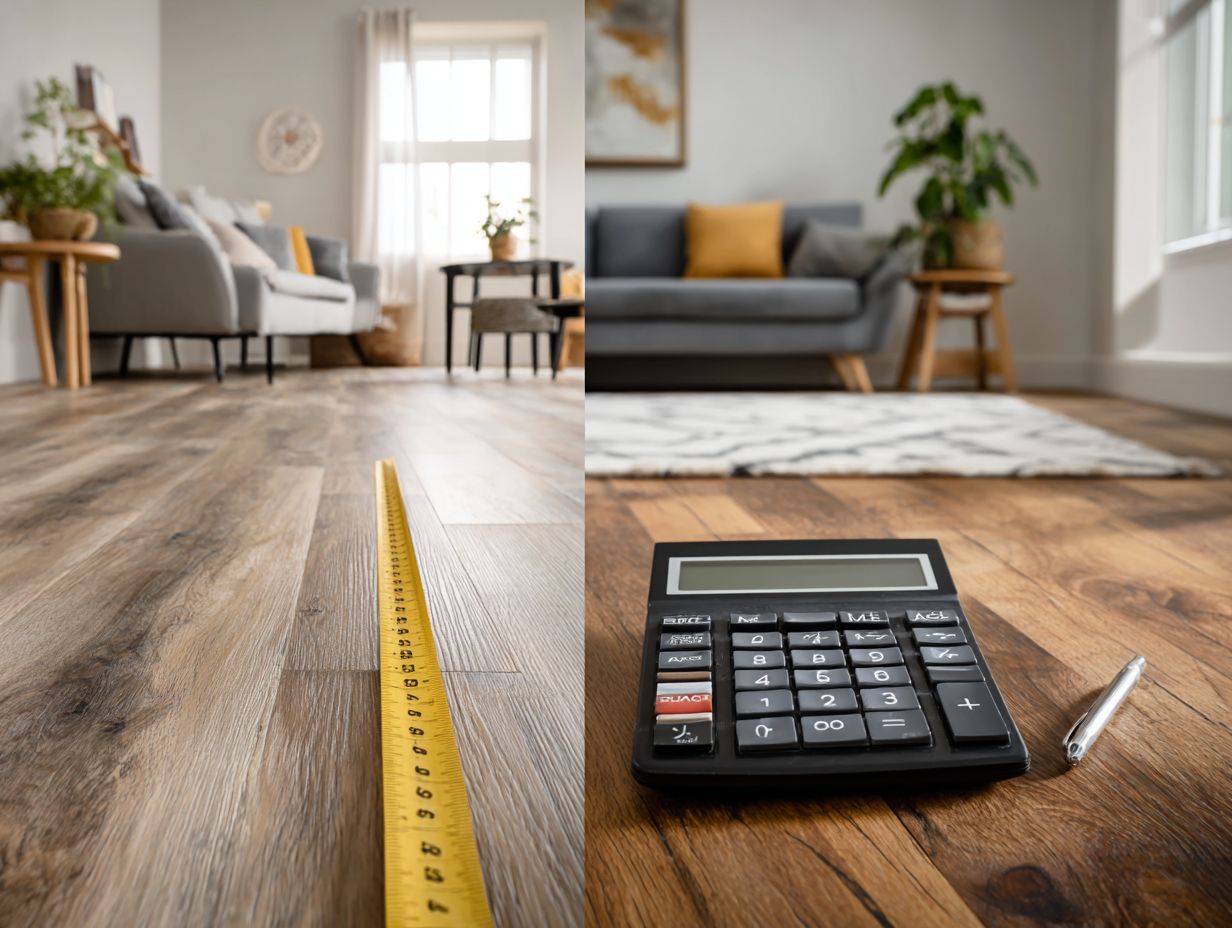
Hardwood flooring is durable and attractive, which makes it a common choice for luxury rentals.
Its attractive look improves any room, while being easier to clean than carpets.
The cost can range from $5 to $15 per square foot, depending on the wood type.
For upscale properties like condominiums and luxury homes, hardwood’s durability is a solid long-term investment, but it may not be ideal for areas prone to moisture, such as basements or bathrooms.
Consider engineered hardwood as a more moisture-resistant alternative, satisfying both beauty and practicality.
Laminate Flooring
Laminate flooring provides a cost-effective alternative to hardwood, replicating its look while offering increased durability.
Typically, laminate flooring costs between $1 and $5 per square foot, while hardwood ranges from $5 to $15. Putting in laminate flooring generally costs around $1 for each square foot. In contrast, hardwood costs between $3 and $8 for the same area, which makes laminate a cheaper option.
It’s simple to maintain this; just sweep regularly and mop occasionally. However, hardwood floors must be refinished every few years to maintain their shine. Laminate resists scratches and stains, making it a suitable choice for busy households.
Vinyl Flooring
Vinyl flooring, particularly luxury vinyl tile, is a top choice for its water-resistant properties and ease of installation.
It is a budget-friendly choice-typically costing between $2 to $5 per square foot-and its strong build makes it a great fit for busy areas in rental properties.
Luxury vinyl tile (LVT) also mimics the look of wood or stone, providing aesthetic appeal without the maintenance of natural materials.
When installing LVT, you can opt for glue-down, click-lock, or loose lay methods, with click-lock being the easiest for DIY projects.
Its water resistance is a significant advantage in kitchens and bathrooms, ensuring longevity even in moisture-prone zones.
Tile Flooring
Tile flooring is renowned for its durability and ease of maintenance, particularly in high-moisture areas like bathrooms and kitchens.
This type of flooring can last for a long time if put in properly, making it an excellent option for lasting use.
Installation can be difficult, especially for DIY enthusiasts because of its weight and the accuracy needed for cutting tiles. To correctly install, use a tile cutter for clean edges and a good leveling compound for a flat base.
Regular maintenance is minimal, typically only requiring sweeping and periodic mopping with pH-neutral cleaner to sustain its appearance. This versatility and easy upkeep make tile a favored choice for many homeowners.
Carpet Flooring
Carpet floors feel cozy and soft, which makes them a great choice for bedrooms and family rooms in rental homes.
It’s essential to consider some drawbacks. Installation costs can range from $2 to $5 per square foot, depending on the type of carpet and padding chosen.
Regular maintenance is important; vacuum frequently and get it professionally cleaned every 12-18 months to maintain its condition. While tenants often appreciate the softness underfoot, carpet can trap allergens and may not appeal to those with allergies.
Finding a balance between these advantages and disadvantages is important to improve tenant comfort and maintain the property’s lasting attractiveness.
Durability Analysis of Flooring Types
Knowing how long different flooring options last is important for deciding on investments in rental properties that will last.
Hardwood Durability
Hardwood flooring can last decades if properly maintained, but it is susceptible to scratches and water damage.
To maximize the lifespan of your hardwood floors, implement these maintenance strategies:
- Regularly clean with a soft broom or vacuum to remove dirt.
- Apply a protective layer every two years.
- Clean up spills right away to prevent too much moisture.
For mitigating scratches, consider using furniture pads and rugs in high-traffic areas. If you notice minor scratches, a simple buffing with fine sandpaper can restore the finish.
Routine inspection helps catch issues early, ensuring your floors remain in excellent condition for years to come.
Laminate Durability
Laminate flooring is designed to withstand heavy foot traffic and is generally more resistant to scratches and dents than hardwood.
Manufacturing methods like high-density fiberboard (HDF) and modern wear layers make laminate more durable. For example, many brands use 12mm-thick HDF for extra strength. Moisture-resistant layers prevent water damage, making the product last longer.
Typically, high-quality laminate can last 15 to 25 years, depending on usage. To further increase longevity, consider regular maintenance practices like sweeping and using a damp mop, avoiding harsh chemicals that could degrade the finish.
Follow these steps to keep your flooring in great shape after it’s installed.
Vinyl Durability
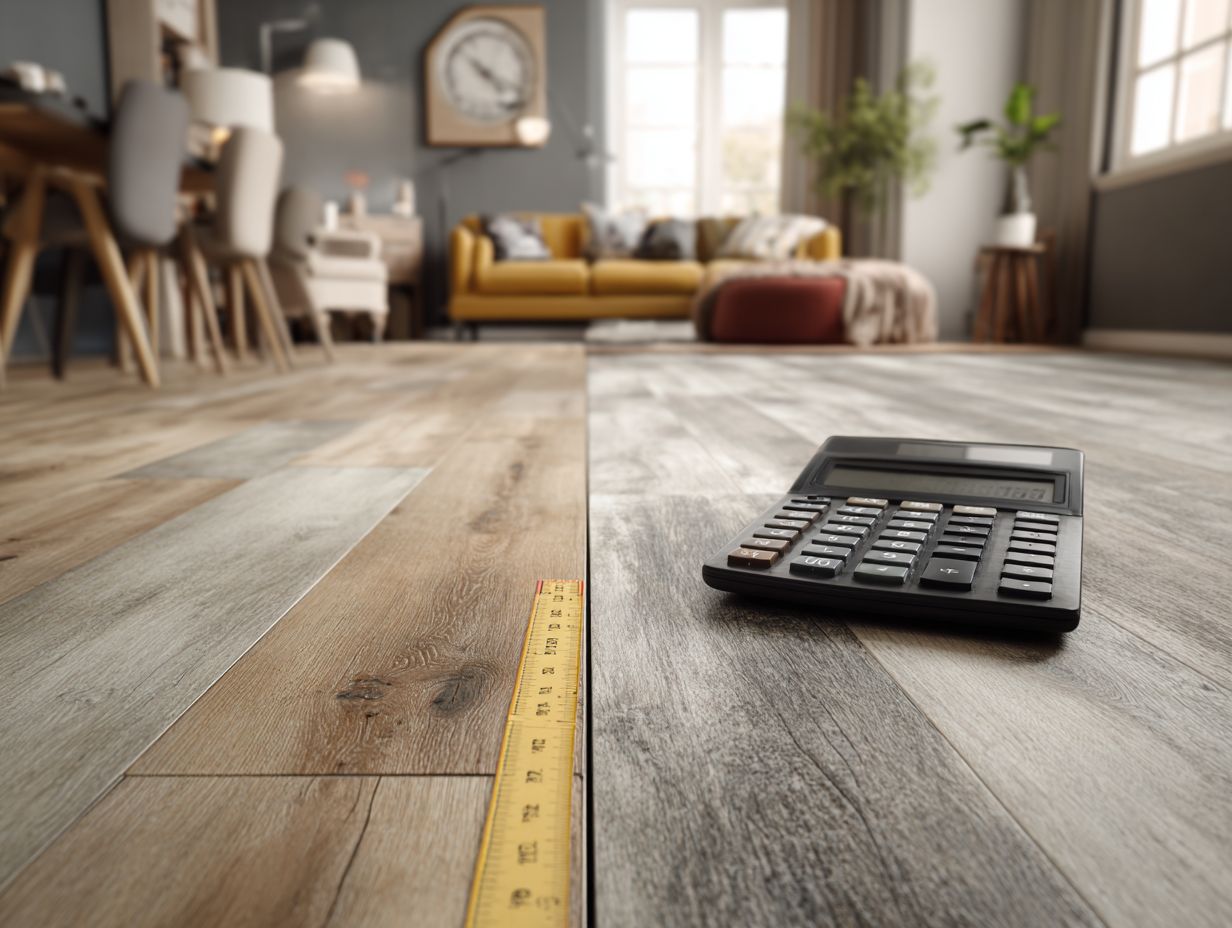
Luxury vinyl flooring is famous for being tough and water-resistant, which makes it great for busy areas and places with a lot of moisture.
This type of flooring is durable against lots of walking, marks, and scratches, so it’s a good choice for homes, businesses, and healthcare facilities.
For best results, look at styles such as rigid core vinyl. It has a thicker wear layer that offers more protection. Many luxury vinyl tiles (LVT) come with a warranty of up to 25 years, ensuring long-term durability.
To maintain its appearance, regular sweeping and occasional damp mopping will suffice, keeping your flooring looking new and resilient against day-to-day wear.
Tile Durability
Tile flooring is durable and resistant to scratches, making it a good choice for lasting use in rental properties.
Available types of tiles include ceramic, porcelain, and natural stone, each offering unique benefits.
- Ceramic tiles are practical and cost-effective, lasting 10-20 years with little upkeep needed.
- Porcelain tiles, more resistant to moisture, can last over 20 years when maintained properly.
- Natural stone tiles, such as granite or marble, provide a high-end look and durability, suitable for a lifespan of 30 years or more, though they may require sealing.
Regular sweeping and occasional mopping with a gentle cleaner can significantly extend the life of all these tile types.
Carpet Durability
Carpet flooring generally has a shorter lifespan than other flooring types and requires regular maintenance to keep it looking fresh.
To make it last longer, regularly vacuum twice a week to get rid of dirt and debris. Think about hiring professionals for a thorough cleaning every 12-18 months to remove stains and odors successfully.
Invest in high-quality padding, as it supports the carpet and reduces wear. If the carpet is in a high-traffic area, select a more durable fiber, like nylon, which resists wear better than polyester.
Use area rugs in heavy use zones to shield the carpet from excessive damage.
Cost Analysis of Flooring Types
Careful examination of the costs for various flooring options is essential for getting the best return on investment in rental properties.
Rental Property Flooring Depreciation
Rental Property Flooring Depreciation
Flooring Depreciation Schedules: Depreciation Periods
Flooring Depreciation Schedules: Annual Depreciation Example
The data on Rental Property Flooring Depreciation gives important information on the projected lifespan and yearly depreciation deductions for different flooring types, which is important for property owners and investors managing rental properties. This information is important for planning taxes and predicting finances.
Flooring Depreciation Schedules indicate the differing depreciation periods for common flooring materials:
- Carpet: Depreciated over a period of 5 years. This relatively short period reflects the material’s susceptibility to wear and tear, necessitating more frequent replacement in high-traffic rental properties.
- Hardwood: With a depreciation period of 27.5 years, hardwood flooring is considered a long-term investment. This lengthy depreciation schedule mirrors its durability and aesthetic appeal, which contribute to its value retention over time.
- Vinyl: Also depreciated over 27.5 years Vinyl flooring is appreciated for being long-lasting and affordable, making it a sensible option for property owners who want durability with a stylish look.
The Annual Depreciation Example provides specific deductions that property owners can apply for tax purposes:
- Carpet: An annual deduction of $600 highlights the more rapid depreciation rate, allowing owners to recover costs quickly through tax deductions.
- Hardwood: The annual deduction of $436.36 reflects its prorated value over the depreciation period, offering a consistent tax deduction benefit year over year.
Knowing these depreciation schedules is important for rental property owners handling their investment collections. Carpet offers quicker cost recovery due to its shorter lifespan and higher annual deduction, while hardwood and vinyl provide long-term value and durability. This information assists in choosing flooring, comparing initial costs with long-term savings and tax consequences.
Initial Costs
Initial costs for flooring can vary significantly based on the type chosen, affecting budget allocations for rental properties.
For instance, laminate flooring ranges from $1 to $5 per square foot, offering an affordable yet durable option.
In contrast, hardwood can cost between $5 and $15, providing a classic look but requiring a larger investment.
Luxury vinyl planks, between $2 to $7, combine aesthetic appeal with water resistance, ideal for bathrooms.
When budgeting, consider installation costs as well; hiring professionals may add $2 to $5 per square foot.
Assessing the total cost can guide landlords in maximizing long-term investment returns.
Long-Term Costs
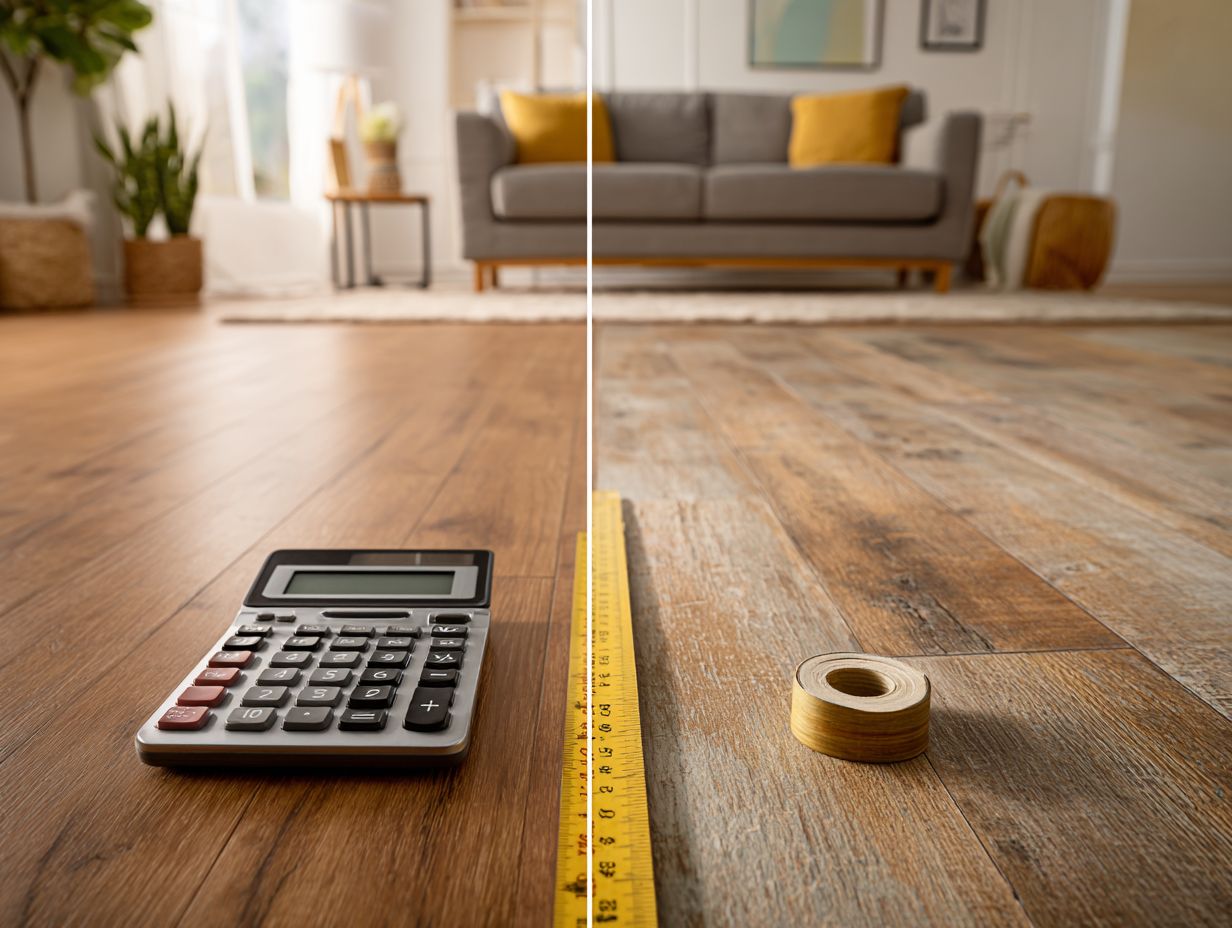
Long-term costs encompass maintenance and replacement expenses, which can impact overall profitability of rental investments.
For example, luxury vinyl plank (LVP) flooring costs about $2-$5 per square foot at first. It can last 15-25 years with little upkeep, which makes it an affordable choice.
Traditional hardwood flooring typically costs between $5 and $10 per square foot. It requires refinishing every 5 to 10 years, which can lead to higher costs over time.
Consider laminate flooring, which can be as low as $1 per square foot but typically lasts only 10-15 years.
Analyzing these factors will help you choose materials that align both with your aesthetic goals and financial strategy.
Return on Investment
Checking how much profit different flooring types bring can help landlords choose options that increase property worth.
To calculate ROI, consider the following formula:
ROI = (Net Profit from Flooring – Cost of Flooring) / Cost of Flooring x 100.
For example, if luxury vinyl plank flooring costs $4 per square foot, with a projected increase in tenant retention reducing turnover costs by $1,000 annually, your ROI can be significant.
Unlike cheaper carpets that might wear out and need replacement every few years, causing more spending and maintenance over time. Prioritize durable, low-maintenance options to maximize ROI over time.
Frequently Asked Questions
What is the best flooring for rental properties if I want to balance durability and cost?
The best flooring for rental properties that balances durability and cost would be vinyl flooring. It is affordable, easy to install, and can withstand high foot traffic and spills.
Is laminate flooring a good option for rental properties?
Laminate flooring is a popular choice for rental properties as it is affordable and durable. However, it is less resistant to water than vinyl flooring and might not perform well with spills and moisture.
How does carpet flooring compare to other options for rental properties?
Carpet flooring may be a cheaper option for rental properties, but it is not as durable as vinyl or laminate. It can easily get stained and worn out over time, making it more expensive in the long term.
Can hardwood flooring be a good investment for rental properties?
Hardwood flooring may be a more expensive option for rental properties, but it can add value to the property in the long run. However, it might not be the best option for busy rental properties.
What are the benefits of using ceramic tiles for rental properties?
Ceramic tiles are a great option for rental properties as they are durable, waterproof, and easy to clean. However, they can be more expensive than vinyl or laminate flooring choices.
Are there any other factors to consider besides durability and cost when choosing the best flooring for rental properties?
Yes, it is important to also consider the style and aesthetic of the flooring, as well as the maintenance and upkeep required. It is also helpful to consult with a flooring professional to determine the best option for your specific rental property.
